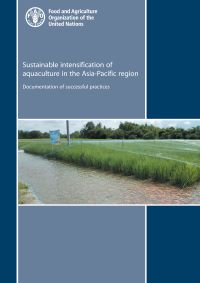Marine capture fisheries as a source of food for aquaculture in the Asian region
4 March 2013 | Simon Funge-Smith | 3785 views | .mp4 | 24.51 MB | Marine finfish, Environment and Sustainability
How much of Asia’s marine fishery catch is directed to aquaculture? Production of low value/trash fish species in the South China Sea region is estimated at over 8.3 million tonnes. The proportion of total catch varies according to area, but consistently exceeds 20 percent of overall catch, and is considerably higher for the trawl fisheries (typically in the range 40–60 percent). Onshore demand for trash fish is booming, due primarily to aquaculture demand, keeping many operations profitable despite the impact on fisheries.
Demand for captured fish in East Asia’s coastal aquaculture is estimated at 1.44 million tonnes for carnivorous fish, and 0.44 million tonnes for lobsters, crabs, and carnivorous mollusc species. The majority of these operations are fed with low value/trash fish from coastal trawl fisheries. Assuming a conversion ratio ranging from 3 to over 6, more than 6.5 million tonnes of fresh fish are required. A large proportion is fed with formulated feed, often containing over 30 percent of fish meal.
An estimated 31 million tonnes of aquaculture production is produced using supplemental or formulated feeds, with fishmeal inclusion ranging from 3–32 percent and conversion ratio of 1–2 kg feed per kg fish produced. This indicates an estimated demand fishmeal demand of 2–3 million tonnes. Asian fish meal is derived from low value/trash fish catch and some small pelagic fisheries, but 56 percent is manufactured from fish processing wastes. Altogether, fishmeal production in Southeast and East Asia is around 988 000 tonnes currently, with Thailand, Japan and China as the major producers.
Thus, 6.5 million tonnes of capture fishery fish are fed directly to aquaculture, and 1.94 million tonnes directed to fishmeal. With 1.1 million tonnes produced in Asia, and 2.18 million tonnes imported, total availability is approximately 3.2 million tonnes fish meal, for a total current fishmeal demand for aquaculture of approximately 2–3 million tonnes per annum.
Asian aquaculture is the world’s major user of fishmeal, and 86 percent of fishmeal used in Asia (excluding China) now goes to aquaculture. With no new sources of fish, many argue that we have already reached the limit in coastal trawl fisheries. But, there is a shift away from using fresh fish directly as feed, towards pelleted feeds incorporating fishmeal, which “stretches” it. New fishmeal fisheries are being explored and exploited, such as the Lantern fish in Iran/Oman, the sardine fisheries in India, and Sardinella in the Bali Straits. Some Asian fisheries are already becoming de facto “low value/trash fish” fisheries, harvesting specifically to supply aquaculture with feeds. This situation is perpetuated by policies and perverse subsidies, first in aquaculture promotion (low taxes, limited environmental regulations), and secondly in fisheries, where subsidised fuel costs justify trawling for a lower value catch. This means that aquaculture is not paying the ‘real price’ for its feeds.
The impact on coastal fisheries caused by trawling is attracting increasing attention from critics and environmentalists, and is the source of some conflict within the industry. Diversity is certainly declining, and in terms of resource use, it is probably more efficient to trawl fish to eat, than to trawl for feeds.
All trawl fisheries generate some bycatch. This could be utilised if the trawling was undertaken responsibly. The use of responsibly sourced fishmeal or fish products is included in aquaculture certification standards. For example, the Aquaculture Stewardship Council has already finalised standards for abalone, bivalves, pangasius and tilapia, and is expected to approve standards for salmon, shrimp and trout by the end of 2012, with Seriola/Cobia to follow.
Global GAP’s Compound Feed Manufacturing Standard (CFM) stipulates that the species of fish used and their countries of origin must be identified. Proof must also be provided that the feed does not contain species classified as critically endangered or endangered on the IUCN Red List.
Global Aquaculture Alliance (GAA)/Best Aquaculture Practices (BAP) is planning to set new standards after 1 June 2015, requiring that at least 50 percent of fishmeal and fish oil derived from reduction fisheries shall come from approved certified sources, and that at least 50 percent of fishmeal or fish oil derived from fishery by-products such as trimmings and offal shall come from approved certified sources.
The Responsible Fishmeal – IFFO RF Standard requires producers to source their whole-fish raw material from fisheries managed according to the FAO Code of Conduct for Responsible Fisheries (MSC certification is accepted as proof of this). Producers must also avoid the use of Illegal, unreported and unregulated fish (IUU), and there must be no sourcing of fisheries by-products from IUCN red-listed fisheries. Manufacturing must be undertaken under a recognised quality control scheme to ensure product safety, purity and traceability.
Increasing competition for human food and growing fish prices and demand will incentivise more innovative use of low value/trash fish (exemplified by the rising trend in surimi production). Declining catches, combined with innovative use of small bony demersal fish and increased use of icing/ preservation, will leave less available for fish meal production.
In conclusion, although most Asian aquaculture is not highly dependent upon fishmeal, the industry will be affected as supplies tighten and costs rise. Increasing scrutiny of sources of fishmeal will also impose increasing compliance burdens on feed manufacturers. The principal impact will be on higher end products, which are most likely to be able to carry the additional costs of alternative ingredients.
Creative Commons Attribution.
